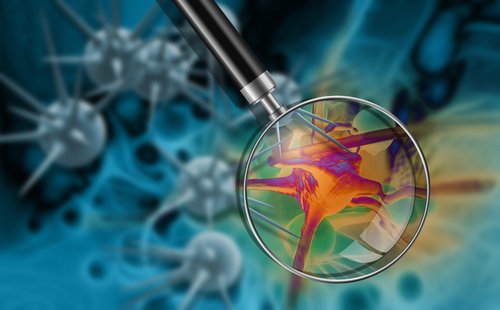CRY-1, a regulator of our circadian clocks, contributes to disease spread and poor outcomes in prostate cancer patients by boosting DNA repair mechanisms that render cells more resistant to treatments, a study reveals.
The findings support further investigation of CRY-1 as a therapeutic target, especially in prostate cancers that fail to respond to current therapies.
The study, “The circadian cryptochrome, CRY1, is a pro-tumorigenic factor that rhythmically modulates DNA repair,” was published in the journal Nature Communications.
Male androgen hormones, such as testosterone, and their protein receptors on cell surfaces are essential in the development and progression of prostate cancer. First-line therapies for men with advanced prostate cancer either deplete androgens or target the androgen receptor.
Although these therapies are effective initially, castration-resistant prostate cancer (CRPC) — cancer that does not respond to androgen-lowering treatments — can arise, a condition for which there is no durable treatment.
Studies suggest that CRPC is still dependent on the androgen receptor through the abnormal reactivation of separate mechanisms that do not rely on androgens. Thus, there is a need to develop treatment strategies that enhance androgen receptor-targeted therapies.
Recently evidence has highlighted the potential of leveraging androgen receptor-dependent DNA repair mechanisms. Most cancer treatments seek to damage DNA in tumor cells, which then triggers cells to self-destruct. However, active DNA repair processes can work against tumor cell death and dampen treatment effectiveness by repairing treatment-induced DNA damage.
A protein known as CRY-1 has been shown to be important in DNA repair mediated by androgen receptor signaling. CRY-1 is produced in response to androgen stimulation in CRPC cells and is strongly associated with cancer spread (metastasis) and poor outcomes.
CRY1 activates genes associated with the circadian (or biological) clock, which synchronizes bodily processes to light and dark rhythms. Several studies have indicated that disruptions in circadian rhythm, such as jet lag, shift work, or sleep disruption, are all associated with an increased risk of prostate and other cancers.
“When we analyzed human cancer data, the circadian factor CRY-1 was found to increase in late-stage prostate cancers and is strongly associated with poor outcomes,” senior author Karen Knudsen, PhD, said in a press release. “However, the role CRY-1 in human cancers has not been explored.”
Researchers based at Thomas Jefferson University in Pennsylvania now conducted a series of experiments to further investigate the function of CRY-1 in prostate cancer.
Experiments showed that CRY-1 was important in prostate cancer cells beyond its circadian functions. In particular, CRY-1 was found to be involved in cancer through DNA replication, cell cycle regulation, and multiple DNA repair processes.
“This was a clear indication of CRY-1’s link to prostate cancer,” said first author Ayesha Shafi, PhD. “As we looked further into the role of CRY1, we unexpectedly found that the circadian factor was altering the way that cancer cells repair DNA.”
Upon DNA damage by radiation, CRY-1 was required to induce a cell cycle checkpoint, which is a process that halts cell division so DNA can be repaired. In CRY-1-depleted cells, there was an 80% reduction in surviving cells after radiation, while in contrast, cell growth was maintained in radiated cells with active CRY-1.
“These findings reveal new insight into CRY1 function as a modulator of cell cycle checkpoint control and cell proliferation in response to [DNA damage] and implicate CRY1 in promoting cancer cell survival,” the team wrote.
An analysis of the impact of DNA damage on CRY-1 function found that CRY-1 protein levels increased in response to escalating doses of radiation, with a threefold increase found four hours after radiation, indicating that the “effects of DNA damage on CRY1 accumulation are rapid,” the team added.
Next, to support clinical relevance, experiments assessed the impact of DNA damage on CRY-1 regulation in CRPC cells derived from prostate cancer patients. Similarly, CRY-1 protein increased in response to radiation treatment in human tissue.
Computational strategies were used to identify mechanisms by which CRY-1 modulates the response to DNA damage. The results revealed that CRY-1 is implicated in regulating factors associated with homologous recombination (HR) — a process critical to repairing DNA during cell division.
“These findings provide the first evidence that CRY1 modulates factors associated with HR, thus regulating response to DNA damage and enhances tumor aggressiveness through these mechanisms,” the researchers wrote.
Finally, CRY-1 deficiency decreased the activity of genes associated with HR after radiation-induced DNA damage. Interestingly, the binding of CRY-1 to these key DNA repair factors was not dependent on hormone stimulation, which supported an “independent role of CRY1 as a protumorigenic factor.” Furthermore, there was an association between CRY-1 levels and the levels of HR factors in metastatic CRPC.
“Combined, these findings identify CRY1 as a tumor-specific, [androgen receptor]-induced effector of poor outcome in [prostate cancer] and identify entirely new functions of CRY1 to temporally control HR and the response to genomic insult,” the investigators wrote.
“Not only have we outlined a role for CRY-1 outside of its canonical function in circadian rhythms, Dr. Shafi’s findings are the first to reveal the means by which CRY1 contributes to aggressive disease,” said Knudsen. “It’s notable that the pro-tumor functions of CRY1 may be viable targets to treat prostate cancer, and this is a direction that Dr. Shafi’s future work will explore.”
The team plans to examine the therapeutic targeting of CRY-1 and investigate other existing therapies that may work together to hinder DNA repair in prostate cancer cells. They also plan to study the connection between circadian rhythm genes and cancer.
“It’s been shown that circadian disruptions can affect efficacy of treatment, but also that aligning treatment with the body’s natural rhythms or giving therapy at certain times of the day can be beneficial,” Knudsen said. “Our findings open up a multitude of important research questions exploring the link between the circadian clock and cancer.”

